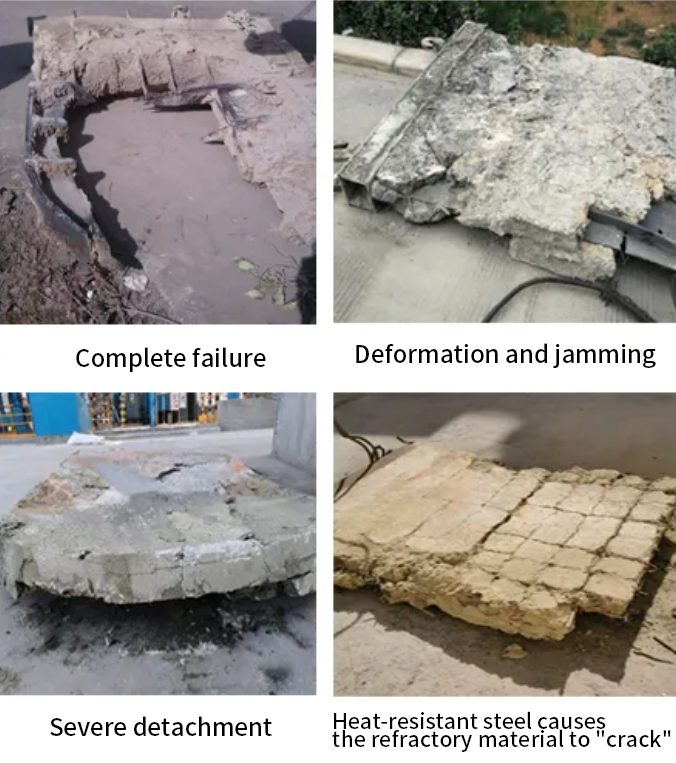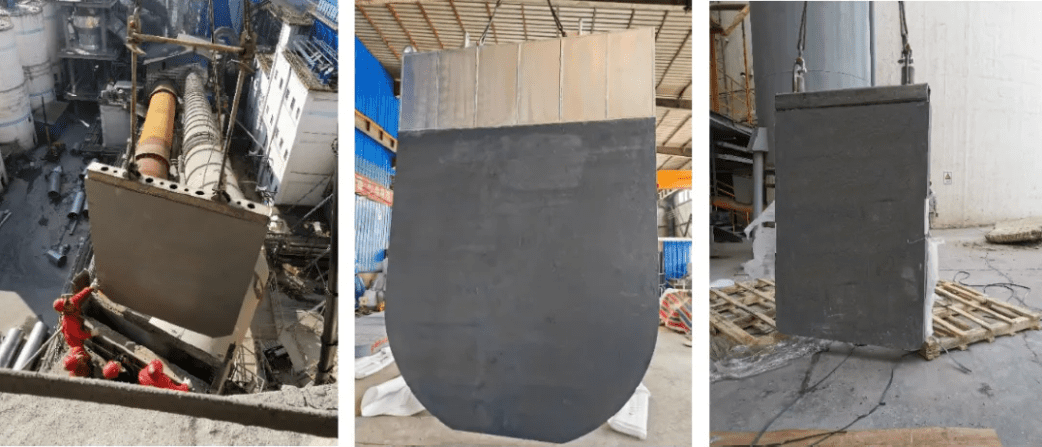01 Issues with Conventional Three-Way Dampers
Darko makes high-performance three-way dampers. They focus on “damper craftsmanship” to improve product quality. Many cement companies face short service lives for their dampers, especially at the kiln inlet. Often, these dampers last less than a year.
Traditional three-way dampers use heat-resistant steel and refractory materials. However, they have several problems:
- Wear-resistant refractory materials do not have enough surface strength for high temperatures.
- The kiln inlet can reach 1400°C. Common refractory materials cannot handle this heat, leading to weak structures.
- Metal materials expand with heat, causing the damper to crack or jam.
- It is hard to control the quality of refractory materials, resulting in inconsistent products.
The various damage forms of traditional three-way dampers made of heat-resistant steel and refractory material are shown in the figure below.

02 Features of Darko Dampers
Darko’s silicon carbide ceramic three-way damper solves these issues. It features:
- Innovative Design: It focuses on modern three-way damper design.
- Prefabricated Delivery: Customers can install the product right away, saving time and costs.
- High-performance Materials: It uses hard silicon carbide and alumina, which resist wear and corrosion.
- Reduced Metal Usage: The main material is ceramic, which lowers metal use and reduces cracking risks.
- Strict Quality Control: The dampers are prefabricated in a factory to ensure quality and reduce breakage risks.

03 Usage of Darko Dampers Near the Kiln Outlet
In June 2018, a cement plant in Henan installed Darko’s three-way damper in a new dry-process rotary kiln with a capacity of 5000 T/D. After five months, inspections showed no cracks or wear. The plant was very satisfied.
In 2020, during maintenance, the Darko damper was still in excellent condition. It showed no signs of wear or breakage, greatly increasing its service life.
04 Usage of Darko Dampers Near the Kiln Inlet
Many cement plants place three-way dampers near the kiln inlet for precise control. However, high temperatures and airflow can deform traditional dampers. Darko’s ceramic dampers can withstand temperatures up to 1300°C while keeping their strength. This ensures they perform well in high-temperature environments.
Currently, Darko dampers are used in several cement plants. They can last up to one year without frequent maintenance, earning high praise from customers.
05 Summary of Darko Damper Usage
Darko dampers near the kiln outlet can last up to two years. In contrast, traditional dampers last only six months. This significantly improves performance. Darko dampers maintain their integrity with minimal wear, which reduces maintenance costs and downtime.
06 Value Analysis of Darko Dampers
The direct benefits include a long lifespan and high cost-effectiveness. Darko dampers last three to four times longer than traditional ones, reducing replacement frequency and safety risks. Prefabricated delivery and easy installation also lower maintenance costs.
The indirect benefits include better cement quality and lower coal consumption. For a 5000 T/D kiln, Darko dampers help stabilize the production of high-quality cement clinker. This value far exceeds the procurement costs. Additionally, Darko’s products support better management and efficiency in the cement industry.
Darko’s prefabricated silicon carbide ceramic three-way damper has a long lifespan and reliable performance. It meets the current needs of the cement industry. This damper provides significant benefits for users.

